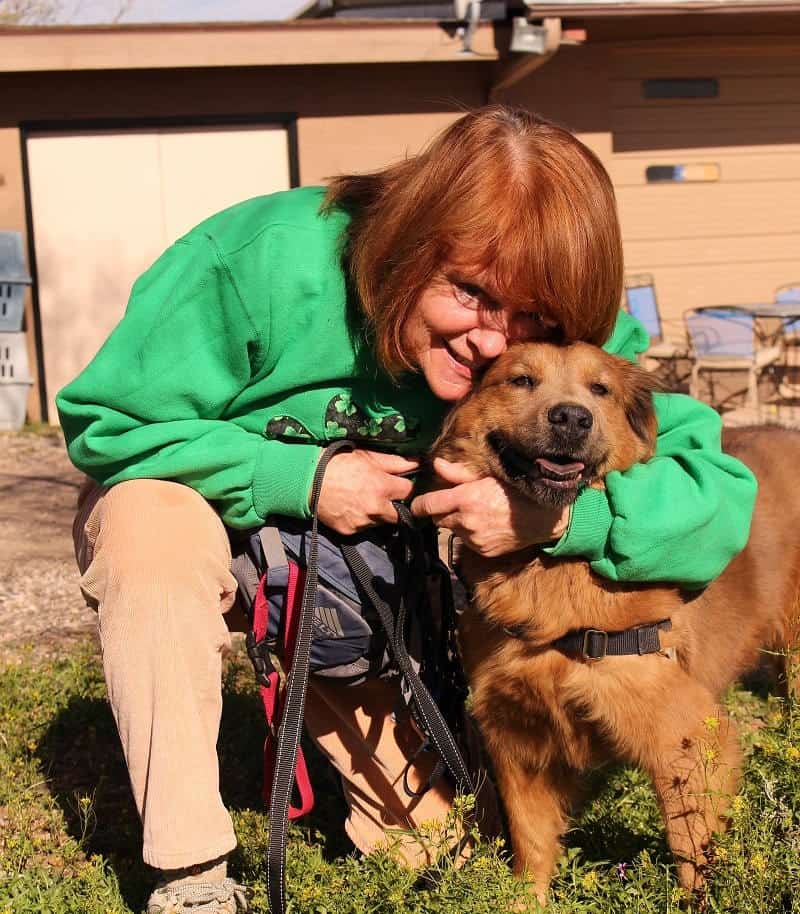Volunteer Clancy Sage serves both humane and historical societies
Clancy Sage hardly ever leaves her house without two things: Dog treats and poop bags. As the owner of three dogs and a dedicated volunteer at the Verde Valley Humane Society, these items are absolute essentials.
Another thing Sage takes wherever she goes is her broad knowledge of and passion for history. Two years ago, she joined the board of the Sedona Historical Society and became a docent at the Sedona Heritage Museum.
Sage grew up in Yonkers, N.Y., but went to college at Arizona State University and studied anthropology, sociology and American history. Her studies had led her to Sedona to research the nearby reservation and American Indian ruins, but it took a lot more time until she discovered the small city as hometown material.
“It was in 1999 that two friends and I came out — one of them had a timeshare in Sedona — and I looked around and I said, ‘I could see myself living here,’” Sage recalled.
She decided to buy a house, but rented it out while she was still living in New Jersey and working in human resources for a large company. In 2009, she was able to receive an early retirement package and came to Sedona one year later.
“It was worth waiting for. Now it’s red rock therapy every day,” Sage said.
At first, Sage volunteered at the Humane Society of Sedona for a number of years, before switching to Verde Valley Humane Society.
“They needed more help down here because they didn’t have the volunteers or the money that Sedona had. So I’ve been here for about two-anda-half years and it’s just unconditional love every day,” Sage said. “It’s funny, I always thought I would drive the Pink Jeeps; that was my thing when I was in college. I always said, ‘I’ll come out here and drive the Pink Jeeps.’ But I love animals, so that was the calling.”
In the beginning, the Verde Valley Humane Society often only had two people volunteering, which made it extremely difficult to take each dog on a walk every day.
“But now we’ve got so many volunteers that every dog gets out every day. And they get to play four days a week,” Sage said.
As the coordinator for offsite adoption events, she aims to provide the dogs with lots of opportunities for socialization to make them more adoptable.
“A lot of people don’t like to come to a shelter because they think it’s sad. But when you take the dogs off-site, people meet them and say, ‘Oh my god, that’s a great dog.’ We do get a lot of adoptions that way.
“Just being able to show that shelter dogs are really happy dogs and there’s nothing wrong with them is great. It’s not their fault they’re here,” Sage said.
For Sage, the only downside to working at the shelter is animals not finding homes as fast as she would wish.
“Our bigger dogs and our black dogs are the hardest to get adopted, and so when they’re here for months and months and months, that’s sad. I like to see them go to good homes. When I still had four dogs, three of them were black, so I don’t get why black dogs are so much harder to adopt out,” she said.
In the end, the dogs’ happiness and well-being is what counts for Sage.
“It’s just so rewarding to see them happy and playing and getting out of their kennels. A lot of shelters’ dogs don’t even get walked, but here they get a lot of attention, and so it’s just a happy feeling. And you feel real good about it, being here and taking care of them.”
Besides animals, history is Sage’s passion. As a docent at the Sedona Heritage Museum, she tells visitors about Sedona’s historical roots and answers all of their questions. Her volunteer position at the museum gives her the opportunity to meet people from all over the world.
“I love history and I love meeting new people. We’ve had people from England there recently, a while back there was a couple from Korea, it’s just amazing,” Sage said.
When she is not doing docent duties, Sage can be found in the museum’s archive room.
“They have book after book after book in there. I’m up to the P’s,” she proudly said. “We were a late-blooming town because of where we were located, and it’s just so interesting to see the hardy people that settled this place. I find that fascinating and reading about it is very rewarding.”
There is only one thing that Sage dislikes about the job at the Heritage Museum: “My least favorite thing about the Historical Society is putting the flag up. I shouldn’t say that, but it always wraps around the pole and the wind pulls it and I just — I mean, I love the American flag, but the fact that I can’t seem to get it up there without it giving me a problem is a problem.”
Every year, the historical tours of the Sedona area narrated by Paul Thompson are Sage’s highlight. Thompson is the grandson of Sedona’s first permanent white settler, Jim Thompson.
“I go every time he comes. He’s this tall cowboy-looking guy and he knows everything about Sedona. There’s not a question you could ask him that he doesn’t know, and I love going on his tours,” Sage said.
When Sage gets home from her volunteer work, putting her feet up is not exactly an option. Now it is her three dogs and four cats’ turn to receive her attention.
“Because I have so many animals, at least I’m not in jeopardy of taking anybody home from the shelter,” Sage said.
Her hands are plenty full with the 28 paws roaming her house already.
“I’m in single digits. I was up to 11 animals at one point and now I’m down to seven, so I’m getting there.”



















